Falmouth Field Trip 2014-
This website reflects the opinions of students and not the views of the University of Southampton or the National Oceanography Centre.
Produced by: Alice Duff, Philippa Fitch, Joanna Gordon, William Harris, Thomas Jefferson,
Eirian Kettle, Jesse Marshall, Dominique Mole, Emma-
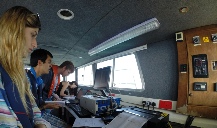
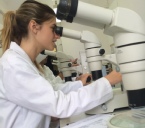
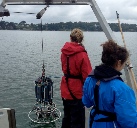
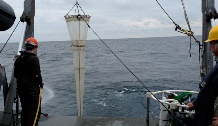



Locating the Fronts
Offshore -
ADCP
Richardson Number
Temperature, Salinity, Density and Turbidity
The aims of the offshore practical were to determine and identify the physical structures of the water column. The temperature and salinity of seawater at 1m depth were used to locate fronts in order to do CTD profiles of the water column. Station 45 displayed characteristics of an estuarine front due to its location and large, shallow thermocline. Temperature and salinity were monitored continuously while between 12:20 and 12:25 UTC. Increasing temperature and salinity was observed (Figure 1), determining the position of Station 48 as this suggested a the presence of a front. A CTD profile was carried out but the water column was found to be still well mixed. This suggested stratification had not fully occurred as expected.
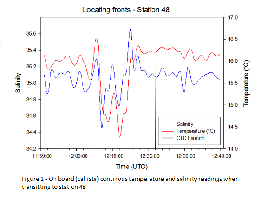
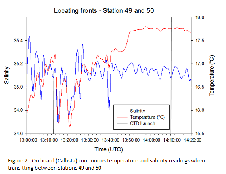
The CTD at Station 49 was deployed at 13:13 UTC when temperature increased indicating a front. Again, soon after the CTD was launched, temperature and salinity reduced indicating that a front had still not been located. The CTD depth profile showed some stratification of the water column. At 13:50 UTC was there a large increase in temperature to 17.75°C, again indicating the location of a front. The CTD was launched at 14:10 UTC and the depth profile showed a stratified water column confirming our assumption as there was a warm water mass overlying a cold one (See Temperature Profile).
Station 45/46
A layering of different backscatter values can be seen with depth. There are few high surface values which are likely to be due to bubbles under the hull of the boat. A more consistent value is seen just below the surface which proceeds to decrease at around 18m.The next layer of less backscatter remains until 35m where it continuously increases to the seabed. Flow velocity remains constant throughout the water column and some small sections of data deeper than 20m were missed when the boat was underway manoeuvring.
Station 47
There are areas of high backscatter in the surface waters shown in the backscatter transects for station 47. Once again these high values may be associated with interference from the boat. At greater depths the deployments from the rear of the Callista (CTD, zooplankton nets) can be shown by the higher values at depth. Surface waters also show higher flow velocities than bottom water.
Station 48
The backscatter transect for this station shows similar trends of inference from the boat and equipment as mentioned for the previous station. The velocity transect for this station is made up of patches of different velocity magnitudes,. This implies there is strong mixing in these areas with a high amount of turnover.
Station 49
A very uniform backscatter is also seen at this station with the various features being due to the interference from the boat rather than the water. The flow velocity is much slower at this station, as the previous station experienced flows greater than 1m/s in some places. There is lots of shear still occurring, shown by the vastly different velocity readings between each ADCP reading.
Station 50
In the upper 20 metres there is further ship related interference. The velocity transect shows that some of the deeper parts were not sampled due to limitations in the range of the ADCP. In the part of the water column that was sampled there is an increase in mixing compared to the rest of the transect .
The Richardson Number (Ri No.) depth profiles were created using ADCP data taken
at each station whilst sampling. As can be seen by the figures (below), all stations
showed dominantly turbulent flow (<0.25 Ri No.) which was to be expected given all
locations were in the tidally dominated English channel. Stations 47-
The line of best fit at Station 48 and 49 (Figures 20-
An occasional very high Ri No. is seen at some stations, for example the shallowest reading at Station 48. These are likely to be anomalies due to false backscatter from objects in the water.
Click the figures below to enlarge and see a short discussion for each station.



A layering in backscatter was seen at the stations that were identified to have fronts present (stations 45/46/50); this is likely to be due to their interactions between the converging water masses with differing quantities of suspended particulate material. The other stations showed more uniform backscatter associated with their well mixed profiles. The expected trend between flow velocity and backscatter was observed as they were in reverse to each other. The stratified water columns demonstrated more laminar flow., whereas those that were well mixed showed turbulent flow.












Click Figures to enlarge
Density increases with depth, therefore the deeper stations such as Station 45 (60.5m)
show the highest density reading (1026.85kgm-
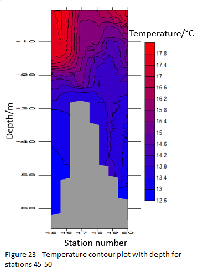
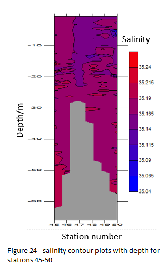
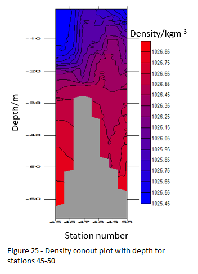
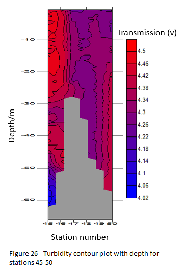
Click figures to enlarge
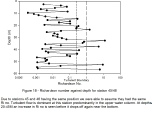
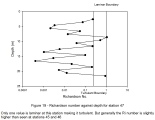
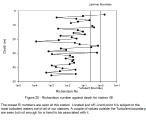
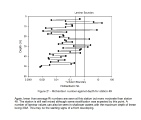
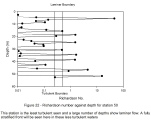
| Geophysics |
| References |
| Introduction |
| Physical |
| Chemical |
| Biological |
| References |
| Introduction |
| Results |
| References |
| Introduction |
| Physical |
| Chemical |
| Biological |
| References |